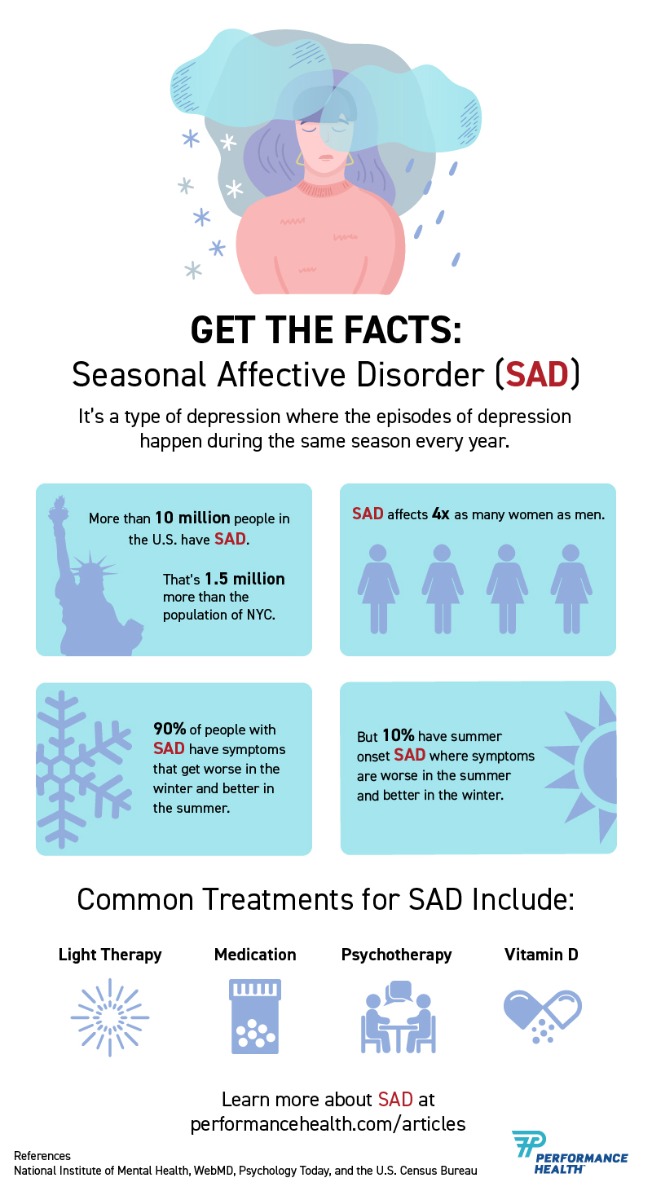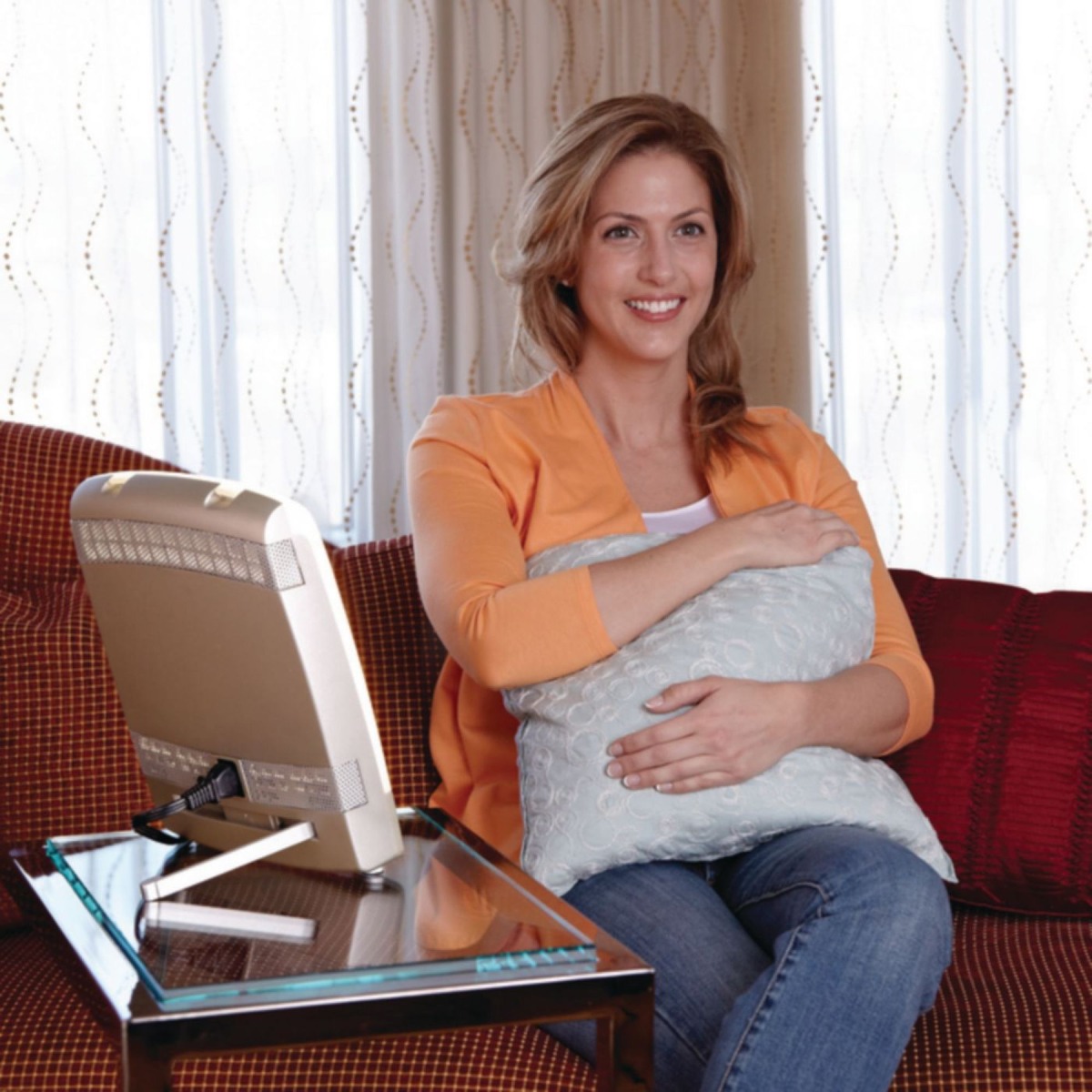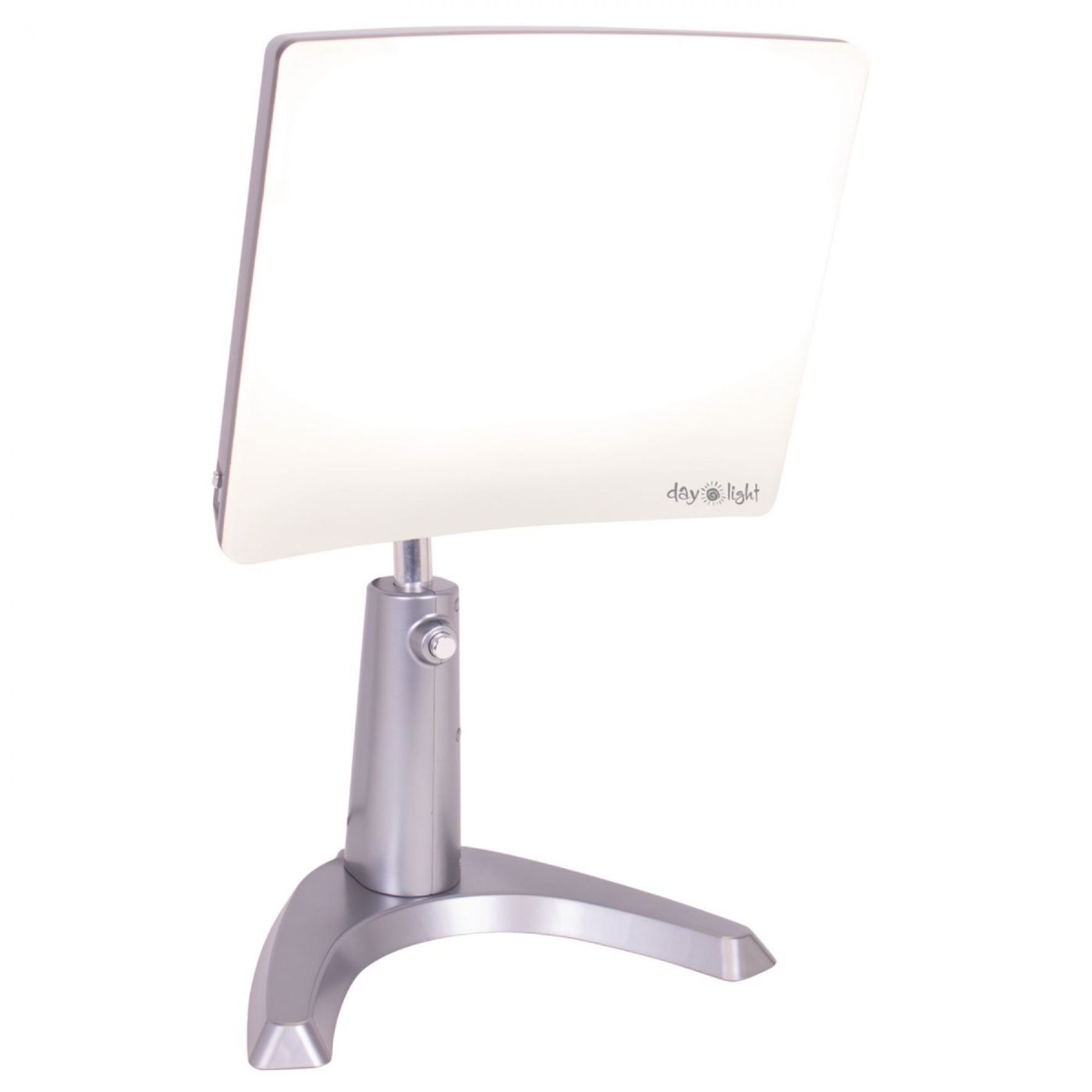Winter brings snow, ice, cold temperatures, and early sunsets when most people are just leaving work. But if you have seasonal affective disorder (SAD) it may also bring episodes of depression. Learn more about SAD and get the answers to frequently asked questions in this article.
What is seasonal affective disorder?
What is the difference between fall/winter onset SAD and spring/summer onset SAD? How is SAD different from the winter blues?
What is a diagnostic criteria for seasonal affective disorder?
What are the symptoms of seasonal affective disorder?
What are the risk factors for SAD?
What causes seasonal affective disorder?
Get the Facts: Seasonal Affective Disorder
What are common treatments used for seasonal affective disorder?
More About Light Therapy
What is seasonal affective disorder?
If you feel depressed and depressive episodes change with the seasons, you may have seasonal affective disorder, also known as SAD. SAD is not a separate disorder, it’s a type of depression which displays a recurring seasonal pattern.
What is the difference between fall/winter onset SAD and spring/summer onset SAD? How is SAD different from the winter blues?
Fall/winter onset SAD occurs when your depressive episodes begin in the late fall or early winter and go away during the spring and summer. This is the more common form of the disorder, and makes up about 90% of all cases.1
However, some people have spring/summer onset SAD, where depressive episodes begin in the late spring or early summer and improve in the fall and winter months. This form is less common and makes up approximately 10% of all SAD cases.1
Around 10-20% of people have a more mild form of SAD, called the “winter blues”.7 While you may feel gloomy and lethargic, the winter blues don’t impact your ability to enjoy your life. If your symptoms affect your work, relationships, and more aspects of your daily life, you may have SAD, not the winter blues.
What is a diagnostic criteria for seasonal affective disorder?
In order to be diagnosed with seasonal affective disorder, people must meet the full criteria for major depression. Their depression must also coincide with specific seasons (appearing in the winter or summer months) for at least two years. The seasonal depressions must be more frequent than non-seasonal depressions.
What are the symptoms of seasonal affective disorder?
Major depression symptoms include:
- Feeling depressed most of the day, nearly every day
- Low energy
- Feeling hopeless or worthless
- Losing interest in activities you once enjoyed
- Sleeping problems
- Problems concentrating
- Changes in appetite or weight
- Feeling sluggish or agitated
- Having frequent thoughts of death or suicide
If you have symptoms of depression, contact your regular doctor. They can test you for depression, help manage your symptoms, and refer you to another medical professional if needed.
Are you or someone you know having thoughts of suicide or dealing with emotional distress? Call the National Suicide Prevention Lifeline now for confidential support at: 1-800-273-8255
Winter Pattern SAD also commonly includes these symptoms:
- Low energy
- Hypersomnia (excessive daytime sleepiness or excessive time spent sleeping)
- Weight gain or overeating
- Cravings for carbohydrates
- Social withdrawal (feeling like “hibernating”)
Summer Pattern SAD also commonly includes these symptoms:
- Anxiety
- Insomnia (problems falling and staying asleep)
- Agitation
- Poor appetite associated with weight loss
- Restlessness
- Episodes of violent behavior
What are the risk factors for SAD?
The following factors may increase your risk of seasonal affective disorder:
- Being female
- Women are diagnosed with SAD 4x more often than men.
- Living further from the equator
- Only 1% of those who live in Florida have SAD, but 9% of people who live in New England or Alaska have SAD.2
- Family history of depression
- People with a family history of other types of depression are more likely to develop SAD than those without a family history of depression.
- Having depression or bipolar disorder
- Your depression symptoms may worsen with the seasons if you have one of these conditions (but SAD is only diagnosed if seasonal depression episodes are the most common)
- Younger Age
- Younger adults are at a higher risk for SAD than older adults. Seasonal affective disorder has been reported in children and teens as well.
What causes seasonal affective disorder?
The exact cause of SAD is unknown, but there are a few biological clues. People with SAD may:
- Have trouble regulating serotonin
- Serotonin is a key neurotransmitter involved in mood. A study found that people with SAD have 5% more serotonin transporter protein in the winter than in the summer.2 More serotonin protein leaves less serotonin at the synapse affecting people’s mood (because the protein is meant to recycle serotonin back to the pre-synapse).
- Overproduce melatonin
- Darkness naturally increases the production of the melatonin hormone, which helps regulate sleep. In the winter, the days become shorter and melatonin production increases. In people with SAD, melatonin may be overproduced leading to feelings of sleepiness and lethargy and delaying their circadian rhythm.
- Produce less Vitamin D
- The sun turns cholesterol from your body into Vitamin D. You may also receive Vitamin D from foods you eat where it is either naturally occurring or added to the food to prevent disorders like rickets. In addition to bone health, Vitamin D is believed to play a role in serotonin activity. Vitamin D insufficiency may be associated with depression symptoms and SAD.
Get the Facts: Seasonal Affective Disorder

What are common treatments used for seasonal affective disorder?
The National Institute of Mental Health states that there are four major types of treatment for seasonal affective disorder. These treatments may be used alone or in a combination.
Light Therapy
Light therapy has been used to treat SAD since the 1980s.2 It’s used to replace the diminished sunlight during the fall and winter months with bright, artificial light. Light therapy treats symptoms of SAD using a light box and can help improve symptoms in 60-80% of people with SAD.3
A light box emits 10,000 lux of cool-white fluorescent light (20x greater than regular indoor lighting) and filter out ultraviolet (UV) rays. People who use a light box typically sit in front of it first thing in the morning for 20-60 minutes each day, from early fall until spring.2
You should keep the light source close, 12-16 inches away, during therapy. You must keep your eyes open (not looking directly at the lamp) but you can eat breakfast, read, or do other activities during this time. Follow your doctor’s instructions for implementing light therapy at home.
When using light therapy, symptoms typically improve in 2-3 weeks. To avoid a relapse, start therapy in the early fall before your symptoms appear.
Light therapy isn’t the right solution for everyone. Consult your doctor before beginning light therapy. People with diabetes or a pre-existing eye condition should talk to a medical professional to avoid damaging your eyesight. Light therapy can trigger mania or hypomania in people with bipolar disorder, speak to your doctor before trying this therapy.
People with spring/summer onset SAD (also known as reverse SAD), who experience symptoms of depression in the summer may not find light therapy effective.
Medication
SSRIs (selective serotonin uptake inhibitors) and bupropion, an antidepressant, can be used to treat seasonal affective disorder. Like all medications, these drugs have side effects. Talk to your doctor about the possible risks of using SSRIs or bupropion to treat your SAD. You may need to try a variety of medication and doses to find the right combination that improves your symptoms without causing problematic side effects.
Psychotherapy
Psychotherapy is also known as “talk therapy”. Cognitive behavioral therapy (CBT) is a type of psychotherapy that has been effective for treating seasonal affective disorder.
CBT-SAD (CBT that has been adapted for people with SAD) involves identifying negative thoughts and replacing them with more positive thoughts. It also focuses on behavioral activation to help the person with SAD identify engaging activities that bring them joy (indoors or outdoors) to help improve their winter coping skills.
Vitamin D
By itself, Vitamin D supplements aren’t used as an effective SAD treatment. Some studies have found Vitamin D supplementation may be as effective as light therapy, while others found that the supplements had no effect. Vitamin D supplements are sometimes used alongside other treatments because low Vitamin D levels were found in people with SAD (due to insufficient dietary/sunshine intake).
Most of these treatments may be given individually or in combination. Talk to your doctor and follow their recommendations on the treatment that will be most effective for you.
More About Light Therapy
Choosing a Light Therapy Lamp
When choosing a light therapy lamp, make sure the lamp filters UV rays for safety and has a lux output of 10,000.
Two of our favorite light therapy lamps are the SunLite and Day-Light lamps. Both block 99.3% of UV rays for eye safety.
Choose Your Light Therapy Lamp |
|
The Economical SunLite Lamp |
The Professional Day-Light Lamp |
|
|
|
|
Learn more about the Day-Light Light Therapy Lamp in this video.
What does the research say about light therapy?
One study found that light therapy and CBT-SAD were comparatively effective for SAD during an acute depressive episode and both could be considered as treatment options.4
Another study found that the effect of light therapy led to an improvement in mood as soon as 20 minutes into the first session. They found that 40 minutes of exposure led to more of an improvement than 20 minutes, but 60 minutes was not more effective than 40.5
Seasonal affective disorder can be managed. Talk to your doctor if you think you may have SAD or have any other questions.
References
- Griffin, R. M. (2019). Tips for Summer Depression. WebMD. Retrieved from https://wb.md/2N7fvWg
- National Institute of Mental Health. (2016). Seasonal Affective Disorder. NIH. Retrieved from https://bit.ly/2QBnE7u
- Cleveland Clinic. (2019). 3 Strategies to Fight Seasonal Affective Disorder. Retrieved from https://cle.clinic/2utGQvi
- Rohan, K.J., et al. (2015). Randomized Trial of Cognitive-Behavioral Therapy Versus Light Therapy for Seasonal Affective Disorder: Acute Outcomes. The American Journal of Psychiatry. Retrieved from https://bit.ly/2QYo0El
- Virk, G., et al. (2010). Short exposure to light treatment improves depression scores in patients with seasonal affective disorder: A brief report. IJDHD. Retrieved from https://bit.ly/302F8wP
- Miller, M.C. (2012). Seasonal affective disorder: bring on the light. Harvard Health Publishing. Retrieved from https://bit.ly/39QomW1
- Psychology Today. (2019). Seasonal Affective Disorder. Retrieved from https://bit.ly/304703D
- Rush University Medical Center. (n.d.). More Than Just the Winter Blues? Retrieved from https://bit.ly/2QBUWDq
Medical Disclaimer: The information provided on this site, including text, graphics, images and other material, are for informational purposes only and are not intended to substitute for professional medical advice, diagnosis or treatment. Always seek the advice of your physician or other healthcare professional with any questions or concerns you may have regarding your condition.








 France
France Australia
Australia




